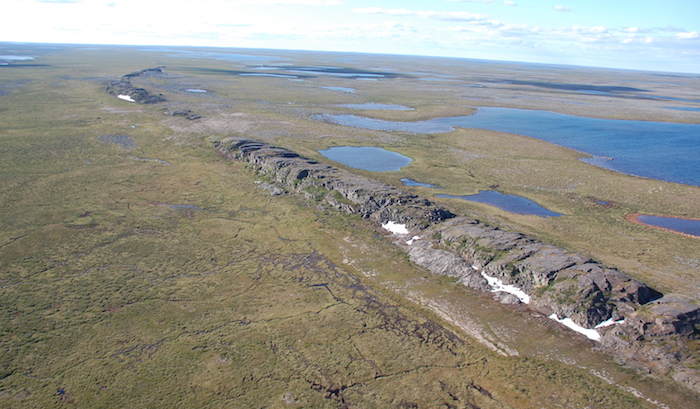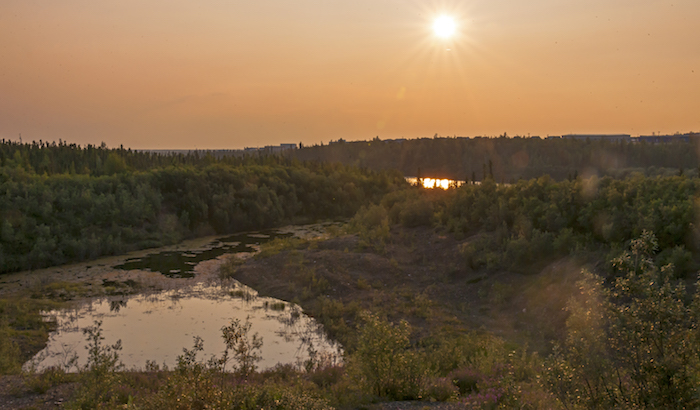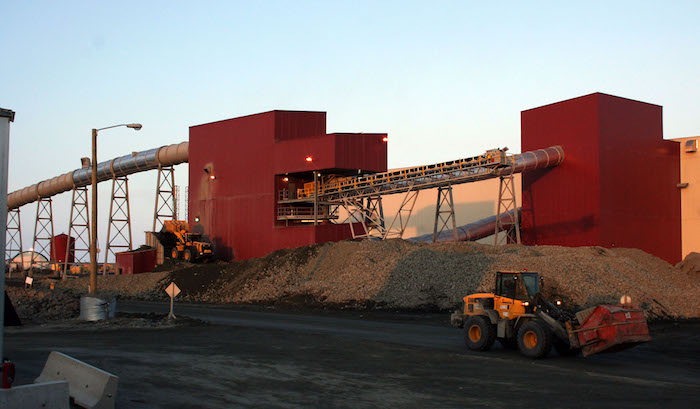When diamonds were discovered in the tundra of the Barren Grounds in far northern Canada, it set off a chain of secrets, deceptions, covert actions, and industrial espionage that make an amazing template for an RPG adventure. Even if you’re not running an actual espionage campaign, PCs could be easily hired on as deniable assets by one of the scrappy underdog companies in an adventure modeled on this thrilling, lower-stakes ‘spy-lite’ tale.
This post is brought to you by beloved Patreon backer Justin Moor. Thanks for helping keep the lights on! If you want to help keep this blog going alongside Justin, head over to the Patreon page – and thank you!

First, a bit about diamond formation. Despite what you were taught in school, coal plus pressure does not equal diamonds. Instead, diamonds are the form elemental carbon ‘wants’ to take in a particular range of high heat and high pressure – a range only found in certain pockets in the upper mantle, beneath the earth’s crust. If diamonds migrate slowly upwards through the crust, they leave this special range, and the carbon in them slowly changes its orientation. The diamonds becomes worthless graphite. Thus, the only way diamonds can get to the surface is if they are shot up through the crust rapidly, carried on eruptions from an unusual type of very deep volcano called a kimberlite pipe. Most kimberlite pipes don’t produce diamonds. Only when a pipe happens to tap into one of these special diamond-producing pockets is it able to bring diamonds to the surface. Along with diamonds, the pipe gushes forth other gemstones that only form in these special pockets, most notably the unusual G10-type garnet. Erosion then disperses diamonds and indicator gemstones around the pipe. Most diamonds are found by sifting the mud of rivers downstream from a kimberlite pipe or by mining the walls of a pipe.
Before the 1990s, Canada was not known for diamonds. Most of the world’s diamonds came from southern Africa (primarily controlled by the notorious De Beers corporation), Brazil, and Siberia. De Beers discouraged its few rivals from looking for other sites to mine. As long as diamond output stayed low, prices stayed high, and everyone profited. But the Canadian mining industry wasn’t part of the cartel. Since the country didn’t produce diamonds, its companies didn’t have longstanding ties to De Beers.
Nonetheless, De Beers was secretly operating in Canada. Starting in the 1950s, De Beers was sending surveyors into the bush to look for the minerals that might indicate a kimberlite pipe lay somewhere upstream. This first came to light in 1982 when a Canadian geologist happened to overhear a bush pilot saying he’d been chartered by a company named Monopros – which the geologist knew to be a wholly-owned De Beers front company. De Beers wasn’t trying to conceal its actions from Canadian law enforcement. It was hiding from the Canadian mining industry, so as not to tip its hand about the great quantities of indicator minerals (including G10 garnets) it was pulling out of rivers in the Northwest Territories. A large camp of 30 samplers and support staff in neat white tents were out in the open if anyone cared to look. But in the far north, 50 miles from the nearest village and 300 miles from the Territories’ only city, who was going to see?

This is where our spy vs. spy action begins. The same geologist chartered a floatplane to a site upstream of the De Beers camp and found G10 garnets. Word got out to a handful of other Canadian geologists, most of whom had their own tiny companies (called ‘juniors’). Soon they were combing the Northwest Territories looking for diamond indicators. De Beers was searching too. The bulk of the action seemed to be in the vast tundra called the Barren Grounds: flat, rocky, and empty. The only way to get around in summer was by floatplane, landing on one of the Barren Grounds’ numberless lakes. In winter, the lakes freeze and can be used as runways. In spring and fall, when the ice is unreliable, transport gets even harder. Teams of samplers crept across the Barren Grounds dressed in camouflage so as not to be visible from the air.
So far, it wasn’t common knowledge there were diamonds in the Barren Grounds. De Beers and the juniors wanted to keep it that way. As soon as word really got out, there would be a staking rush. Mining claims in Canada are adjudicated by the government. They’ll sell you a bag of stakes with metal tags on them, and you can go into the wilderness, pound your stakes into the ground to mark off an area, and report back what you did. You then begin leasing from the government the mineral rights to the land you’ve staked. Flying around to stake out the boundaries of your claim is expensive and time-consuming. Worse, stakes are a matter of public record. A couple new claims here and there go unnoticed, but if someone suddenly starts leasing large swaths of Crown lands in the Barren Grounds, other miners perk up. They’ll start staking their own claims without even knowing yet what they’re staking them for. So De Beers and the juniors had to work quietly to stave off a staking rush. Each hoped they would be the first to find the cluster of kimberlite pipes they were sure was out there. Then they could quickly stake their claim and secure it before somebody else staked it on accident as part of the inevitable big rush.
This is a great place to insert the PCs. Whatever fictional setting you play in, I guarantee mining and mineral rights are a thing. Maybe instead of diamonds, folks are digging up Dark Iron, Corundum, or Space Gems, but the principle is the same. If your PCs are opposed to one (or all) of the mining companies sniffing around your setting, maybe they want to set off a staking rush. Maybe the big corporation is the profit-earning wing of some evil organization. Maybe the big corporation is itself evil (probably not a stretch). Either way, a staking rush this early in the game is likely to be disastrous for the corporation. If the PCs catch wind of what’s going on and can gather and publicize enough solid evidence, they can get every Tom, Dick, and Harry in your fictional equivalent of Yellowknife to fly out to the wilderness and stake their claim. Odds are, one of these nobodies will hit the mother lode, and the big corporation will get nothing.

By 1991, things were getting serious. Many of the juniors had partnered up with a big Australian mining company called BHP. BHP staked a chunk of land around a particular lake that was overflowing with indicator minerals, but had trouble finding the kimberlite pipe. It soon turned out the pipe was the lake: the pipe had collapsed in on itself and filled with water. While De Beers and the other juniors kept combing the Barren Grounds, BHP hired a drilling company to take some core samples. The drillers weren’t told what they were looking for. BHP even gave their lake a deceptive name: Point Lake. There already was a Point Lake in the Northwest Territories, so if the drillers gossiped about working at Point Lake, BHP’s competitors would waste time looking in the wrong place. The results from the drilling were very promising.
When winter arrived at the end of 1991, events were accelerating. Folks back in Yellowknife, the Territories’ only city, were growing increasingly skeptical of BHP’s cover story, that they were looking for gold. BHP was staking claims, as were De Beers and a junior named Aber Resources. The stakers started cutting corners to claim more ground faster. In the midst of blizzards, helicopter pilots were just tossing stakes out the window every 1,500 feet instead of landing and pounding them in place like they were legally required. If someone wanted to contest it, they could claim a bear had come along and knocked the stake over. Most of the ground near Point Lake was now claimed.

In early 1992, Aber Resources pulled a stunt of their own. Aber had plenty of local geological knowledge, but no diamond expertise – Canada wasn’t a diamond-producing country, after all. Everyone was pretty sure BHP believed Point Lake was a diamond-rich kimberlite pipe. But what geophysical characteristics did such a pipe possess? How could Aber tell if they had one in their claim? Aber attached a bunch of geophysical sensors to a helicopter and flew it right over the top of Point Lake, scanning for everything under the sun. The BHP employees on the ground shouted and waved their arms, but they couldn’t do anything to stop the helicopter. There’s no law against flying over leased land, and if your helicopter happens to be carrying geophysical sensors, so what? BHP wrote Aber a strongly-worded letter. Aber ignored it.
These sorts of schemes aren’t unusual in the diamond business. One of the BHP geologists and an ex-Aber geologist turned independent junior had once pulled a similar stunt against De Beers in Botswana. Under cover of darkness, one of them drove out to a De Beers mine in the Kalahari desert and found a place where some of the tailings (rock waste) had fallen through the chain link fence ringing the property. He collected samples and passed them to the other geologist, who analyzed them to learn what mineral indicators existed in the tightly-guarded De Beers mine.
Canadian prospectors too had a tradition of deceit. To mislead their competitors, they’d leave bogus maps lying around purporting to show where they were going to stake claims. They’d hold fake conversations within earshot of their rivals. They’d steal soil samples from each others’ sheds and overfly each others’ claims. Espionage was just part of the game. The stakes were lower than, say, trading nuclear secrets in West Berlin, but the shenanigans were standard spy stuff.

In the spring of 1992, the staking rush began. It turned out there were several diamond-bearing kimberlite pipes in the Barren Grounds, distributed across multiple companies’ claims. With the word out, the companies that had been so quiet began publicizing every little discovery. Stock prices soared and geologist-owners became rich on the capital gains alone, regardless of any actual diamonds found.
That summer, a dog got loose from the Aber camp. It traveled sixty miles until it encountered more humans – in a BHP camp. The phone number on its tag was from far-off Vancouver. After some confusing back-and-forth, BHP reached the dog’s owners in the Aber camp. Aber offered to fly the five minutes by helicopter it would take to get their dog back. BHP refused. They suspected this was another dirty trick by Aber – that overflying their camp wasn’t enough. Aber wanted to land in it so they could see… something. No one was quite sure what, but this whole ‘lost dog’ thing was surely a set-up. BHP put the dog on the next flight to Yellowknife, and Aber was able to pick it up there. By foot and by plane, the poor pup traveled five hundred miles after he got lost.
Aber finally found a pipe of its own on its claim in 1994. When they pulled up a core sample that made it clear they were sitting on hundreds of millions of dollars of diamonds, the Aber camp immediately went into lockdown. They didn’t want to spook the market or their competitors with wild rumors; they wanted to release this news on their terms, at a time and place advantageous to them. No one was allowed in or out of the camp without clearance. Aber cut off the phone, changed the locks on the core tent and the computer room, and loaded up the core sample to physically carry to the outside world: no chance of the signal getting intercepted.

Image credit: YK Times. Released under a CC BY-SA 3.0 license.
We’ve talked about what to do if the PCs want to spoil the chances of a big mining company. What if instead they’re hired on as deniable agents for a company in your fictional setting? The Point Lake diamond rush provides us with a variety of scenarios the party might get thrust into:
- A rival company clearly thinks they’ve found something big, but your only lead on its location is its name – and that’s a dead end. Where is this big strike?
- Infiltrate a competitor’s camp to steal their core samples.
- Conceal the bad staking your company did. Find evidence that a rival company did bad staking so your company’s lawyers can contest their claims and take them over. Tangle with your counterparts doing the same job for your competitor.
- A spotter noticed a competitor’s outpost loaded a bunch of sensor equipment on a helicopter and they’re spinning up to take off. Can you create a navigation hazard to drive them away without crossing the line into attempted murder?
- What do you do with this lost dog that wandered into your camp? Is that a camera built into its collar?
- A competitor’s outpost has gone dark. Have they locked down because of a big discovery? If so, what is it? What if they’re not in lockdown, but went dark for a more sinister reason?
–
Source: Diamond: A Journey to the Heart of an Obsession by Matthew Hart (2001)






